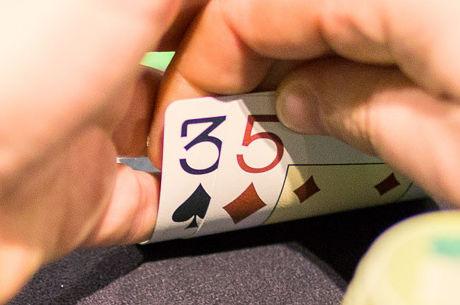Casino Poker for Beginners: Keep Your Hole Cards Hidden

Ed. note: For those who might have missed it before, we're reprising Robert Woolley's series of articles for poker players who are new to live poker. The series is great for newcomers, and likely useful as well to those with experience playing in casinos and poker rooms.
In these last several "Casino Poker for Beginners" articles, I've spilled all I know about poker chips and about the different kinds of buttons that show up on casino poker tables. Now it's time to discuss another piece of indispensable poker equipment — the cards.
I know what you're thinking: What can there possibly be to know about cards? 52 of 'em, right? Four suits of 13 each, and the ace of spades the prettiest card in the deck.
Well, yeah. But there's more — much more.
Poker Cards — Built to Bend
Let me start with one prominent feature of casino poker cards that differs from those typically used in home games. Most decks of cards are made of paper, often coated with a thin layer of plastic. But those used in poker rooms are of much higher quality, and they are also much more expensive. They are made of plastic.
In this regard, poker cards differ even from those used in other areas of the casino, such as at the blackjack tables. Cards there are cheap, meant to be used once, or perhaps a few times, then disposed of. But poker cards are meant to be used and reused as long as possible.
The reason for this difference lies primarily in the fact that players surreptitiously marking cards to gain an advantage is a constant problem in blackjack, and the easiest way to combat that is to replace the decks at such a high rate that a cheating player can't keep up.
But marking cards is generally much less of a problem in poker rooms, so the economics favor investing in durable cards that can be kept in play for months before needing to be replaced.
I'm explaining this because there is an important practical consequence that is not immediately obvious. The plastic poker room cards can be bent almost unmercifully, and still spring back to their original shape without suffering a crease. And that fact matters because it allows you to look at your cards in a way that would be problematic if they were made of paper.
Protect Your Hand from Prying Eyes
It is obviously important that your opponents not see your hole cards. If they do, they can play perfectly against you, and you are at their mercy.
But if you're using paper-based cards that crease easily when bent too far, you're pretty much forced to lift them off of the table in order to see what you have without damaging the cards.
In your home game, you may be able to trust your friends not to sneak peeks at your cards when you do this. But if you lift them completely off of the table in a casino, I can absolutely guarantee that it will cost you money, because the strangers sitting next to you can't be relied on to observe your home-game code of honor.
This doesn't mean that every opponent will look every time. But it only takes one other player seeing what you're holding one time in order for you to lose all the money you have on the table.
You probably learned the basic concept of "defensive driving" at some point in your life: assume the worst of everybody who shares the road with you. With this mindset, you think ahead to what you'll do if the car in front of you suddenly brakes for a squirrel, or the one approaching the intersection from the right doesn't see his red light, or that semi passing you pulls back into your lane before he's fully clear.
You have to approach casino poker with the same kind of cynicism. While you're being friendly and keeping the game fun for everybody, you need to remember that poker is war, and the other players are the enemy. They want to take your money, and some of them will take ethical shortcuts to do so. Your job is to thwart them on all fronts.
Please remember this simple precept: Never lift your cards off of the table. Nothing good can come from it, and lots of bad things can happen.
Have you ever heard a person described as one who keeps his cards "close to the vest"? It means somebody who doesn't readily share his thoughts and plans. The expression derives from poker.
When cards were made of paper, without the benefit of even a thin coating of plastic, they were fragile, and couldn't tolerate much bending at all. That meant players had to lift them off of the table, giving others an opportunity to peek.
There's a famous shot of Paul Newman in The Sting playing high-stakes poker on a train — if you've seen it, you'll remember it — where he becomes the literal embodiment of this phrase, with his cards held right against his vest as he carefully looks down at them.
Your Peeking Technique
You can peek at your cards by lifting just one corner. I've seen lots of different techniques for doing this. The photo up top shows the one that has become habitual for me.
Notice how the cards are angled so that the corner with the identifying information is pointed at me. Both hands are cupped around this corner. I lift the corner with my right thumb. If I need to separate the two cards a little bit in order to see both of them, a small pinching movement between my right thumb and index finger does the job without breaking the visual "seal" of my hands.
With this method, any other player inclined to try to peek at my cards while I'm looking at them would have to crawl into my lap to do so.
And here (finally) is where it pays off to understand the literal plasticity of the cards — you can bend that corner back as far as you need to without worrying that you'll crease it and ruin the card. Of course, you can crease them if you really try, but it won't happen inadvertently. Take advantage of this fact. Bend that corner to identify your cards without making them vulnerable to snoops by lifting them off of the table.
There's much more to know about poker room cards, and I'm out of space. More about cards in my next article.
Photo: Nina Tovish. Robert Woolley lives in Asheville, NC. He spent several years in Las Vegas and chronicled his life in poker on the "" blog.
In this Series
- 1 Casino Poker for Beginners: Taking a Seat in Your First Game
- 2 Casino Poker for Beginners: How to Keep or Change Seats in a Cash Game
- 3 Casino Poker for Beginners: Playing Your First Round
- 4 Casino Poker for Beginners: Rules and Etiquette Regarding Poker Chips
- 5 Casino Poker for Beginners: How to Handle Chips When Betting & Raising
- 6 Casino Poker for Beginners: Chip Rules, Chip Tricks, Collecting & More
- 7 Casino Poker for Beginners: The Deal With the Dealer Button
- 8 Casino Poker for Beginners: Missed Blinds, Seat Change & Other Buttons
- 9 Casino Poker for Beginners: Kill & Half-Kill Buttons, Overs and More
- 10 Casino Poker for Beginners: Lammers, Rebuy Buttons, Add-Ons and More
- 11 Casino Poker for Beginners: Keep Your Hole Cards Hidden
- 12 Casino Poker for Beginners: Marked Cards, Automatic Shufflers & More
- 13 Casino Poker for Beginners: Exposed Cards, Fouled Decks & Other Oddities
- 14 Casino Poker for Beginners: What It Means to 'Protect Your Hand'
- 15 Casino Poker for Beginners: When to Keep Your Cards Covered
- 16 Casino Poker for Beginners: Etiquette When Sharing Space at the Table
- 17 Casino Poker for Beginners: Bonuses, Jackpots, Drawings & Other Promos
- 18 Casino Poker for Beginners: Talking 'Table Stakes'
- 19 Casino Poker for Beginners: The One Thing You Can't Discuss at the Table
- 20 Casino Poker for Beginners: Be Careful Whenever Using 'Action' Words
- 21 Casino Poker for Beginners: Make a Mistake? Three Ways to Respond
- 22 Casino Poker for Beginners: Get to Know Poker Room Personnel, Part 1
- 23 Casino Poker for Beginners: Get to Know Poker Room Personnel, Part 2
- 24 Casino Poker for Beginners: A Few Unusual House Rules
- 25 Casino Poker for Beginners: Chopping Blinds - Etiquette & Expectations
- 26 Casino Poker for Beginners: Don't Do This When Playing With a Friend









